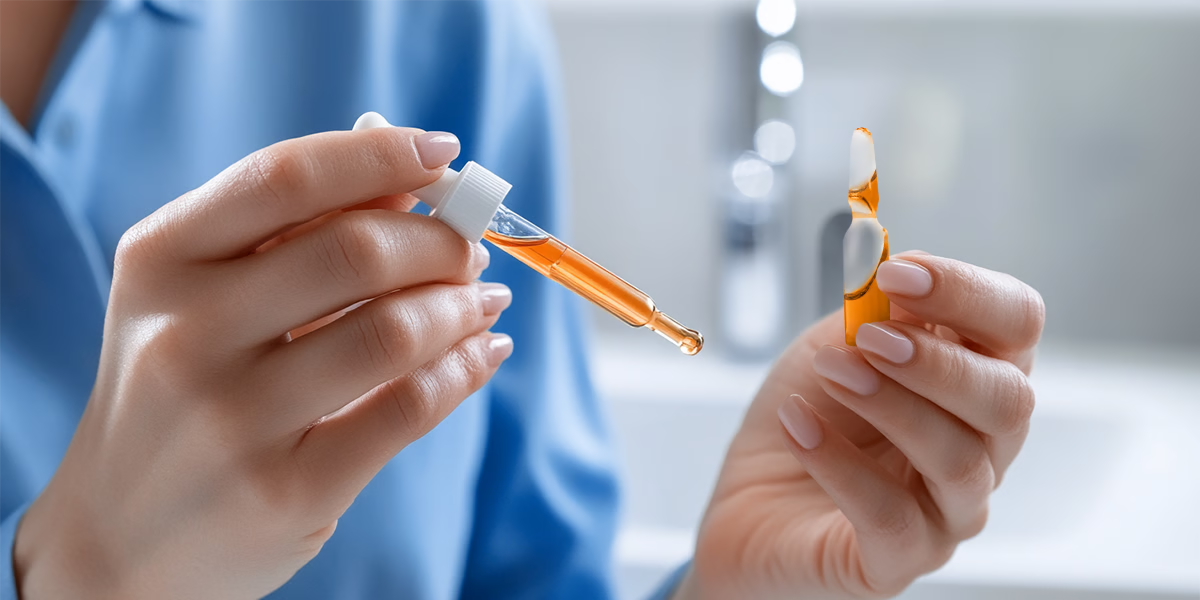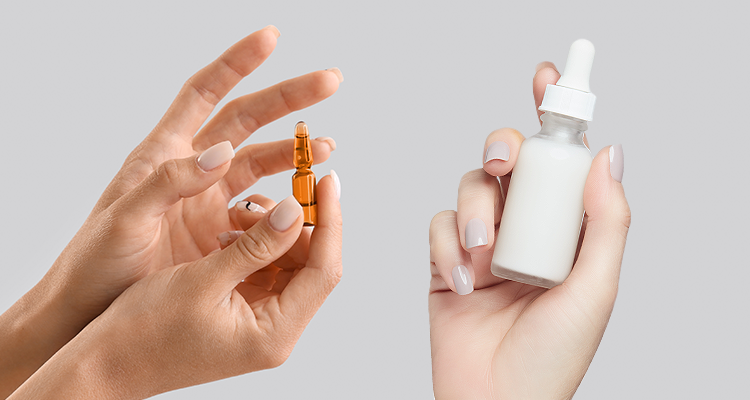
It seems like you need a college degree these days in order to shop for skincare products. It can be overwhelming to see how many different products are available. Words like ampoule, moisturizer, exfoliant, toner, serum, ampoule, and cleanser may be thrown around without you knowing the distinctions between them. Particularly, serums and ampoules can be difficult to distinguish, even for experts in skincare. Making the distinction will enable you to address your skin concerns more effectively and save money.
Understanding serums
Concentrated and light in consistency, serums are meant to be used prior to moisturizer but after cleanser and exfoliant. For extended periods of time, they can be used to target and treat skin issues like wrinkles, dullness, and dryness. The most widely used serums contain glycolic acid, retinol, vitamin C, niacinamide, and vitamin E.
Benefits of use
As part of your regular skincare routine, a serum is suitable for daily use and frequently suggested if you are looking to address common skin concerns, such as combating aging or moisturizing and hydrating without the use of thicker moisturizers that might clog pores.
When should I use them?
Depending on your individual needs, different serums should be used at different times and places in your skincare routine. Assume you wish to treat wrinkles and slow down the aging process. This can be accomplished by applying sunscreen underneath your foundation and plumping and hydrating your skin with an under-eye cream. Applying a hydrating serum beforehand can help your skin absorb the moisture and maintain its smoothness for a longer period of time.
Understanding ampoules
The term “ampoule” refers to the tiny glass vials used to store chemical samples. In the context of skincare, ampoules relate to both the vial’s tiny amounts of concentrated active ingredients as well as the container itself.
Benefits of use
In order to target particular issues, like hydration or wrinkle reduction, ampoules usually contain higher concentrations of ingredients and are designed to penetrate the skin more quickly. In contrast to a serum, an ampoule’s single-use container may be advantageous for components like vitamin C, which in a long-use bottle may oxidize if exposed to air and sunlight over time.
When do I use them?
Ampoules are advised if you want to address an urgent skin concern in a shorter amount of time due to their high active concentration. Benefits include, but are not limited to, treating skin dehydration from traveling to arid areas, minimizing hyperpigmentation from acne scars, and minimizing fine lines in the days preceding important events.
During some seasons, you can also include ampoules in your skincare routine. Certain parts of the world experience dryness and dullness during the winter, so using hyaluronic acid to increase hydration or vitamin C to brighten may be appropriate in the short term. Ampoules work best when used as an additional concentrated treatment that is applied after cleansing but before moisturizing.
Comparing ampoules and serums
It is important to keep your timeline and goals in mind when you are looking to buy new skincare products.

Key differences
The concentration of the products—and, consequently, the duration of use—distinguishes a serum from an ampoule. Ampoules are meant to be used sparingly because they contain a higher concentration of ingredients than serums and can cause skin irritation if used excessively. Serums are softer on your skin and can be used long-term to yield effects.
Assume you have chapped skin. You start incorporating a hyaluronic acid hydrating serum into your daily skincare routine to address dryness. For daily hydration, you apply this serum once in the morning and once at night. In one month, you will be taking a weeklong vacation to a place with a dry climate. To offset the effects of the climate and reinforce what is already a part of your daily routine, apply an ampoule the night before you depart, one in the middle of the week, and one immediately at the end.
Key similarities
Both products have a light consistency and are designed to be applied in tiny drops. Both are used sparingly for the same skin concerns and are brimming with active ingredients. The active ingredients in question may consist of peptides, moisturizers, and antioxidants.
Recalling our example with the dry skin, hyaluronic acid might be the active component in both your ampoule and daily serum. But the amount of that ingredient in each will usually vary; an ampoule may contain closer to 2% of the ingredient, while a serum may contain anywhere from 0.1 and 1.5%.
Both types of products are recommended to be used after washing your skin with cleansers and before emollients like a face oil or moisturizer.
Categories and regularity of treatment
Depending on what your skin needs, different product usage schedules and frequencies are advised. For serums, there are four general categories:
- Hydrating (hyaluronic acid or niacinamide). Twice daily as added moisturizers, morning and night, to help maintain moisture balance.
- Antioxidant (vitamin C, green tea). Once in the morning; antioxidants may help protect against UV damage and free radicals.
- Retinol. 2–3 times per week in evenings, to minimize discoloration and enhance cellular turnover.
- Peptide. Twice daily to support skin repair and elasticity.
Although they fit into the same categories, the best use of ampoules depends entirely on the problem you are trying to solve. Before using the product, carefully read the instructions.
Incorporating these products into a routine: practical steps
Even though you know the general distinctions between serums and ampoules, you might not know how to proceed in real life. Understanding your skin type, specific skincare concerns, and which products work best together will help you decide whether to incorporate these into your routine.
Identifying your skin type and concerns
Different skin types will show different traits; for example, a hydrating serum might work well for dryness but not for acne. To determine your type, cleanse your face with a gentle cleanser, wait an hour, and observe. It is oily if the skin looks shiny; it is dry if it feels tight and flaky; it is combination if the skin exhibits different characteristics in different places; and it is normal if the skin is balanced without having too much sebum or being too dry.
Picking a serum or ampoule type
Depending on the problem you want your product to solve, there are different active ingredients to look for. In addition to being suggested for reversing sun damage, lightening dark spots, and stimulating the production of collagen, which helps make the skin smooth and plump, vitamin C serum might be a great option for treating dullness.
If you have dry, flaky skin, look for gentle ingredients like vitamin E, hyaluronic acid, niacinamide, or glycolic acid. Retinol is advised for the treatment of acne as well as the reduction of skin scarring and hyperpigmentation.
Layering skincare products
Always apply skincare products in the proper layers. Cleaning should be done first, followed by essences and exfoliants to get your skin ready for treatment, and finally, serum. Oil-based serums should be applied after the lightest, water-based serums, as they absorb the fastest. After hydrating serums, use ampoules or serums containing active ingredients (such as vitamin C or retinol). Apply a moisturizer or emollient last to seal in the product’s effects.
Customizing your routine
Your product rotation can be tailored to the specific skin concerns you are trying to solve. For example, it is advised to use an antioxidant serum in the morning to guard against exposure to free radicals, and to use deep hydrators at night. Ensure that your regimen is customized to your skin type.
Expert tips and recommendations
It may feel necessary to stock up on as many products as possible to have the healthiest possible skin, but experts recommend that less is more.
According to the American Academy of Dermatology, you should keep your routine simple and avoid using lots of anti-aging products as they can irritate and damage your skin. Choose products that address basic skin health as well as your most urgent skincare concerns.
Product recommendations
It can be quite difficult to find a product that suits your needs and does not break the bank. Search based on category — hydrating, anti-aging, peptide, or antioxidant — and make sure you select products that are dermatologist-approved.
Be sure to select products that suit your particular skin type, and refrain from using ampoules and serums excessively as this can irritate your skin. To assess your skincare requirements and desired outcomes, it is advisable to speak with a dermatologist.
FAQ
Can I use ampoules and serums together?
It is possible to combine ampoules and serums in one layer. The best way to put this is as adding an ampoule to your regular routine and “boosting” it. Take care not to combine too many different types at once, as their active ingredients can irritate the skin if used excessively or can counteract each other’s effects. Make sure you investigate which ingredients work best as layers.
How long does it take to see results?
Results from serums can take weeks or months to manifest, whereas ampoules are more concentrated and can show results in a matter of days or weeks. A new product may occasionally be introduced with no noticeable results; this could be because the type or concentration of ingredient is not the best fit for your skin type. When adding new products to your routine, always seek professional advice and be ready to make some minor experiments.
Are ampoules suitable for sensitive skin?
Depending on the ampoule, yes. Because of their rapid absorption and concentrated active ingredient content, ampoules can generally cause reactions in skin that is sensitive to other substances. When using a new product, always get advice from a dermatologist if you have known skin sensitivity.
How often should I use serums in my routine?
Depending on the serum, some should be used every day and others just a few times a week. More aggressive products like retinol should only be used two or three times a week; gentler products, like hydrating serums, can be used as often as twice a day.
Key takeaways:
- Concentrated and light in consistency, serums are meant to be used prior to moisturizer but after cleanser and exfoliant. For extended periods, they can be used to target comparable skin conditions.
- Higher concentrations of ingredients that target particular issues (like hydration or wrinkle reduction) and absorb into the skin more quickly are found in ampoules. Extended usage may result in irritation.
- Depending on what your skin needs, different product usage schedules and frequencies are advised. Hydrating, antioxidant, retinol, and peptide are the four main types of serums and ampoules.
- An easy skincare regimen is ideal. Experts advise choosing products according to your particular skin type and needs and advise against using ampoules and serums excessively as this can irritate your skin.









Leave a Reply